BMP3005 - Analyzing Financial Health with Statements & Ratios
VerifiedAdded on 2023/06/14
|14
|2922
|404
Report
AI Summary
This report provides a comprehensive overview of financial management, emphasizing its importance in organizational sustainability and profitability. It explains key concepts, financial statement types (income statement, balance sheet, and cash flow statement), and the application of financial ratios (profitability, efficiency, and liquidity) for performance analysis. The report includes a practical section with calculations and interpretations of these ratios based on provided financial data, offering insights into a company's financial health. Furthermore, it offers recommendations for improving financial performance, such as debt recovery, expense management, pricing strategies, and asset utilization, ultimately aiming to maximize wealth for investors and enhance the firm's valuation. The report concludes that effective financial management is crucial for any enterprise aiming for long-term success.
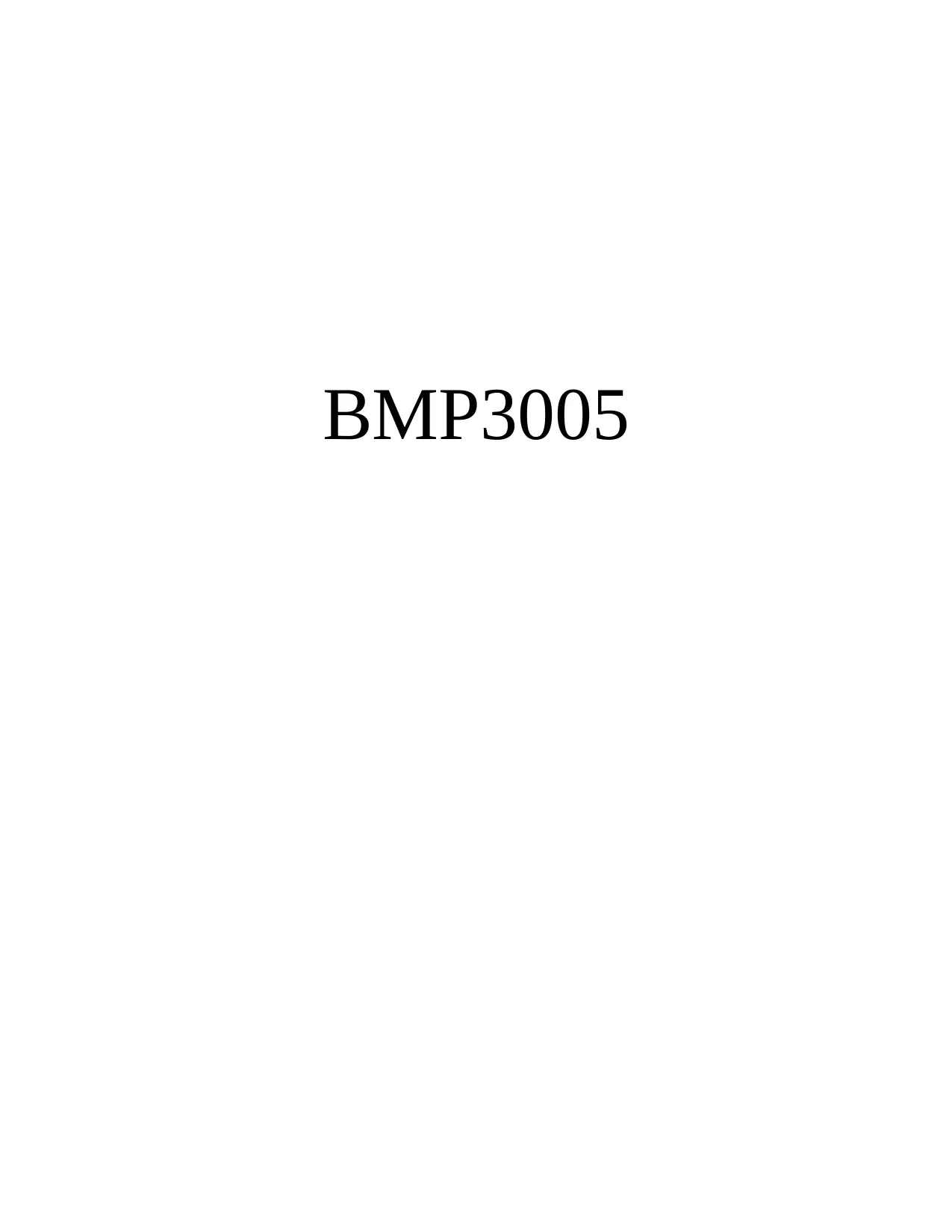
BMP3005
Paraphrase This Document
Need a fresh take? Get an instant paraphrase of this document with our AI Paraphraser
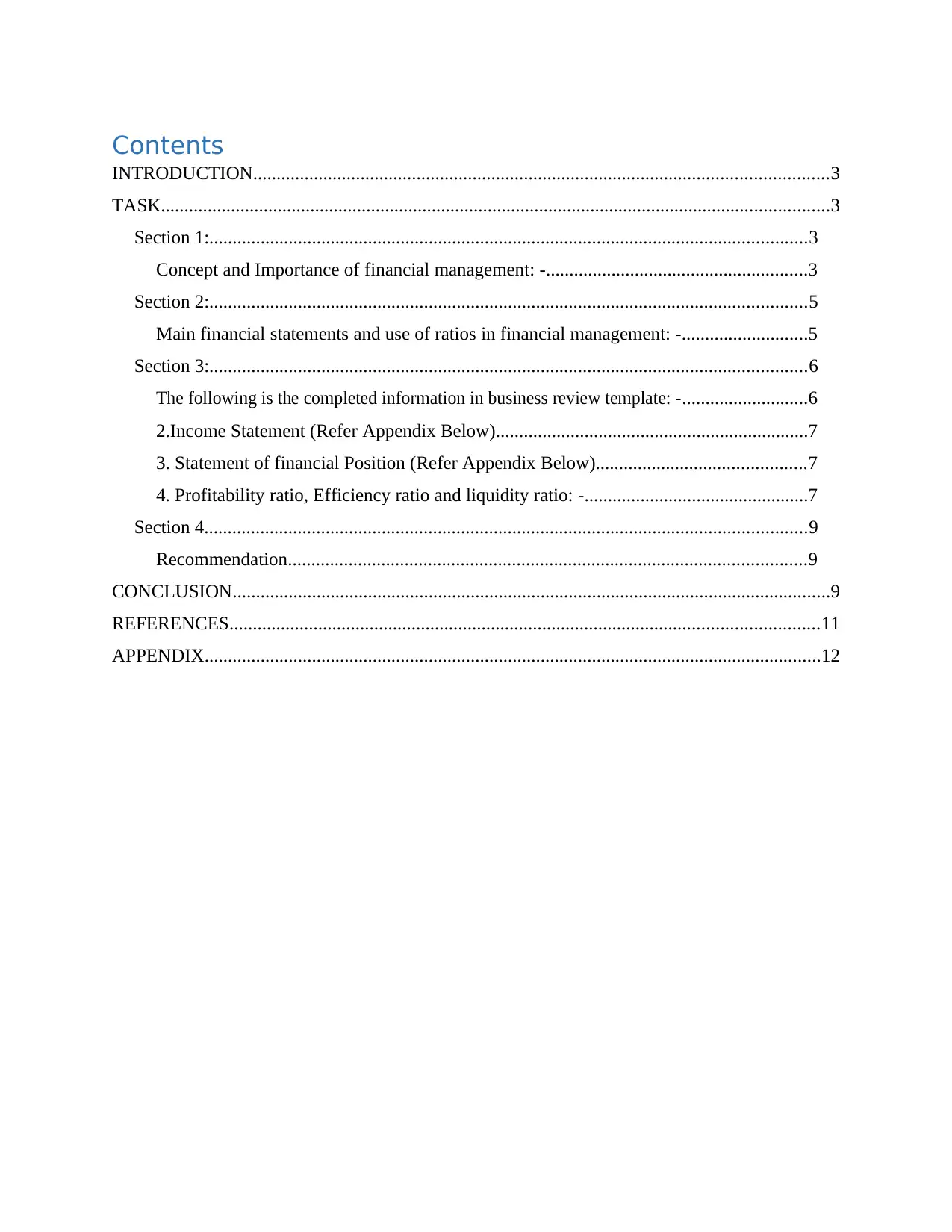
Contents
INTRODUCTION...........................................................................................................................3
TASK...............................................................................................................................................3
Section 1:................................................................................................................................3
Concept and Importance of financial management: -........................................................3
Section 2:................................................................................................................................5
Main financial statements and use of ratios in financial management: -...........................5
Section 3:................................................................................................................................6
The following is the completed information in business review template: -...........................6
2.Income Statement (Refer Appendix Below)...................................................................7
3. Statement of financial Position (Refer Appendix Below).............................................7
4. Profitability ratio, Efficiency ratio and liquidity ratio: -................................................7
Section 4.................................................................................................................................9
Recommendation...............................................................................................................9
CONCLUSION................................................................................................................................9
REFERENCES..............................................................................................................................11
APPENDIX....................................................................................................................................12
INTRODUCTION...........................................................................................................................3
TASK...............................................................................................................................................3
Section 1:................................................................................................................................3
Concept and Importance of financial management: -........................................................3
Section 2:................................................................................................................................5
Main financial statements and use of ratios in financial management: -...........................5
Section 3:................................................................................................................................6
The following is the completed information in business review template: -...........................6
2.Income Statement (Refer Appendix Below)...................................................................7
3. Statement of financial Position (Refer Appendix Below).............................................7
4. Profitability ratio, Efficiency ratio and liquidity ratio: -................................................7
Section 4.................................................................................................................................9
Recommendation...............................................................................................................9
CONCLUSION................................................................................................................................9
REFERENCES..............................................................................................................................11
APPENDIX....................................................................................................................................12
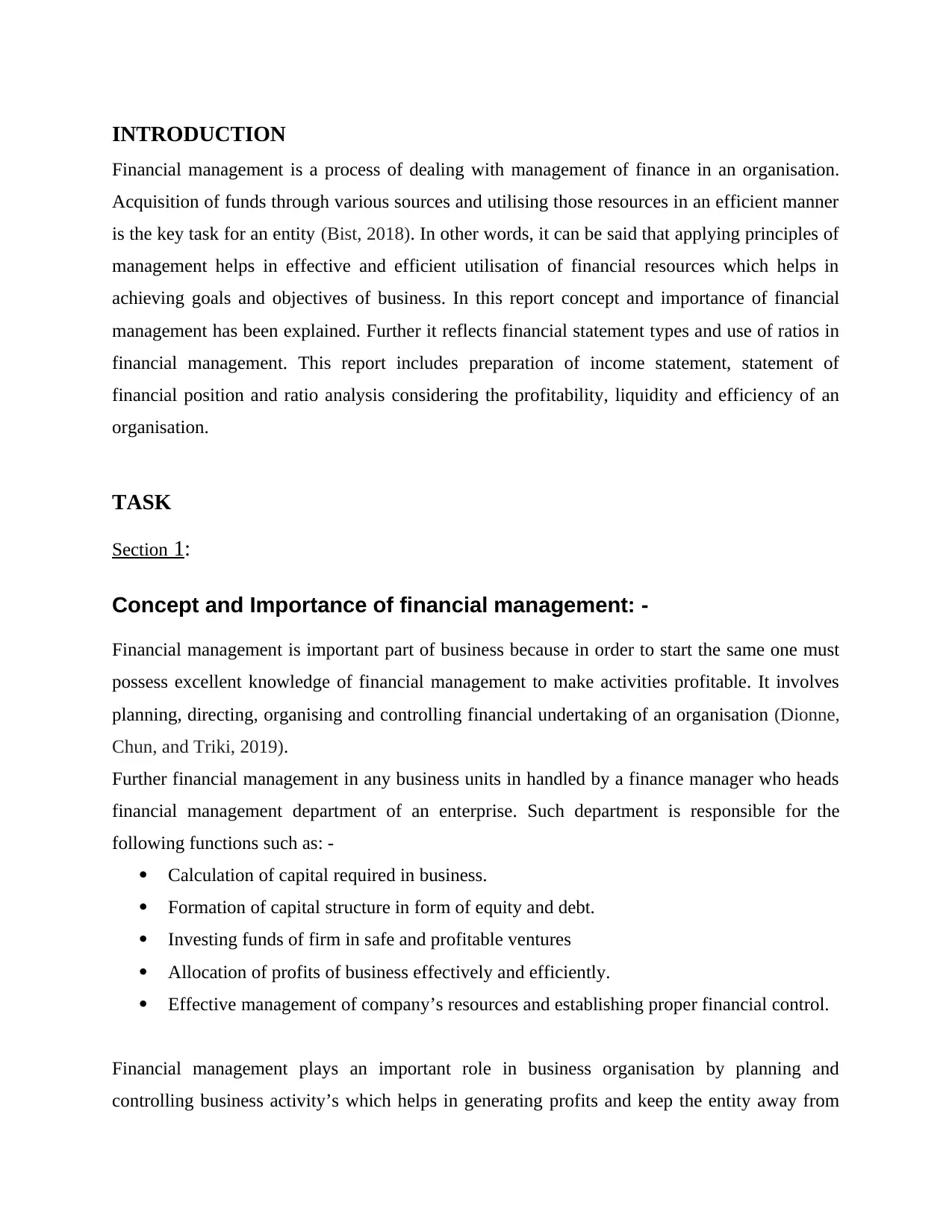
INTRODUCTION
Financial management is a process of dealing with management of finance in an organisation.
Acquisition of funds through various sources and utilising those resources in an efficient manner
is the key task for an entity (Bist, 2018). In other words, it can be said that applying principles of
management helps in effective and efficient utilisation of financial resources which helps in
achieving goals and objectives of business. In this report concept and importance of financial
management has been explained. Further it reflects financial statement types and use of ratios in
financial management. This report includes preparation of income statement, statement of
financial position and ratio analysis considering the profitability, liquidity and efficiency of an
organisation.
TASK
Section 1:
Concept and Importance of financial management: -
Financial management is important part of business because in order to start the same one must
possess excellent knowledge of financial management to make activities profitable. It involves
planning, directing, organising and controlling financial undertaking of an organisation (Dionne,
Chun, and Triki, 2019).
Further financial management in any business units in handled by a finance manager who heads
financial management department of an enterprise. Such department is responsible for the
following functions such as: -
Calculation of capital required in business.
Formation of capital structure in form of equity and debt.
Investing funds of firm in safe and profitable ventures
Allocation of profits of business effectively and efficiently.
Effective management of company’s resources and establishing proper financial control.
Financial management plays an important role in business organisation by planning and
controlling business activity’s which helps in generating profits and keep the entity away from
Financial management is a process of dealing with management of finance in an organisation.
Acquisition of funds through various sources and utilising those resources in an efficient manner
is the key task for an entity (Bist, 2018). In other words, it can be said that applying principles of
management helps in effective and efficient utilisation of financial resources which helps in
achieving goals and objectives of business. In this report concept and importance of financial
management has been explained. Further it reflects financial statement types and use of ratios in
financial management. This report includes preparation of income statement, statement of
financial position and ratio analysis considering the profitability, liquidity and efficiency of an
organisation.
TASK
Section 1:
Concept and Importance of financial management: -
Financial management is important part of business because in order to start the same one must
possess excellent knowledge of financial management to make activities profitable. It involves
planning, directing, organising and controlling financial undertaking of an organisation (Dionne,
Chun, and Triki, 2019).
Further financial management in any business units in handled by a finance manager who heads
financial management department of an enterprise. Such department is responsible for the
following functions such as: -
Calculation of capital required in business.
Formation of capital structure in form of equity and debt.
Investing funds of firm in safe and profitable ventures
Allocation of profits of business effectively and efficiently.
Effective management of company’s resources and establishing proper financial control.
Financial management plays an important role in business organisation by planning and
controlling business activity’s which helps in generating profits and keep the entity away from
⊘ This is a preview!⊘
Do you want full access?
Subscribe today to unlock all pages.

Trusted by 1+ million students worldwide
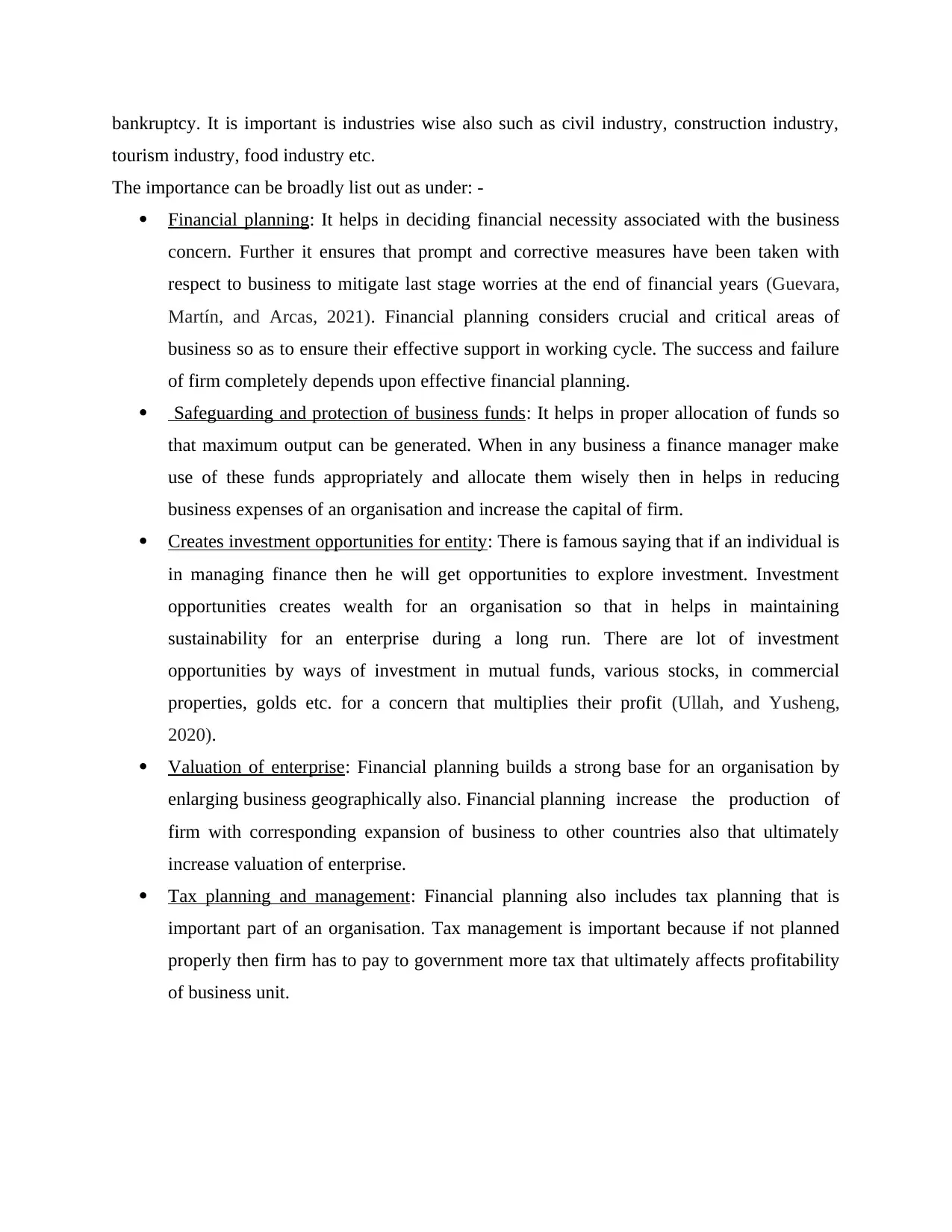
bankruptcy. It is important is industries wise also such as civil industry, construction industry,
tourism industry, food industry etc.
The importance can be broadly list out as under: -
Financial planning: It helps in deciding financial necessity associated with the business
concern. Further it ensures that prompt and corrective measures have been taken with
respect to business to mitigate last stage worries at the end of financial years (Guevara,
Martín, and Arcas, 2021). Financial planning considers crucial and critical areas of
business so as to ensure their effective support in working cycle. The success and failure
of firm completely depends upon effective financial planning.
Safeguarding and protection of business funds: It helps in proper allocation of funds so
that maximum output can be generated. When in any business a finance manager make
use of these funds appropriately and allocate them wisely then in helps in reducing
business expenses of an organisation and increase the capital of firm.
Creates investment opportunities for entity: There is famous saying that if an individual is
in managing finance then he will get opportunities to explore investment. Investment
opportunities creates wealth for an organisation so that in helps in maintaining
sustainability for an enterprise during a long run. There are lot of investment
opportunities by ways of investment in mutual funds, various stocks, in commercial
properties, golds etc. for a concern that multiplies their profit (Ullah, and Yusheng,
2020).
Valuation of enterprise: Financial planning builds a strong base for an organisation by
enlarging business geographically also. Financial planning increase the production of
firm with corresponding expansion of business to other countries also that ultimately
increase valuation of enterprise.
Tax planning and management: Financial planning also includes tax planning that is
important part of an organisation. Tax management is important because if not planned
properly then firm has to pay to government more tax that ultimately affects profitability
of business unit.
tourism industry, food industry etc.
The importance can be broadly list out as under: -
Financial planning: It helps in deciding financial necessity associated with the business
concern. Further it ensures that prompt and corrective measures have been taken with
respect to business to mitigate last stage worries at the end of financial years (Guevara,
Martín, and Arcas, 2021). Financial planning considers crucial and critical areas of
business so as to ensure their effective support in working cycle. The success and failure
of firm completely depends upon effective financial planning.
Safeguarding and protection of business funds: It helps in proper allocation of funds so
that maximum output can be generated. When in any business a finance manager make
use of these funds appropriately and allocate them wisely then in helps in reducing
business expenses of an organisation and increase the capital of firm.
Creates investment opportunities for entity: There is famous saying that if an individual is
in managing finance then he will get opportunities to explore investment. Investment
opportunities creates wealth for an organisation so that in helps in maintaining
sustainability for an enterprise during a long run. There are lot of investment
opportunities by ways of investment in mutual funds, various stocks, in commercial
properties, golds etc. for a concern that multiplies their profit (Ullah, and Yusheng,
2020).
Valuation of enterprise: Financial planning builds a strong base for an organisation by
enlarging business geographically also. Financial planning increase the production of
firm with corresponding expansion of business to other countries also that ultimately
increase valuation of enterprise.
Tax planning and management: Financial planning also includes tax planning that is
important part of an organisation. Tax management is important because if not planned
properly then firm has to pay to government more tax that ultimately affects profitability
of business unit.
Paraphrase This Document
Need a fresh take? Get an instant paraphrase of this document with our AI Paraphraser
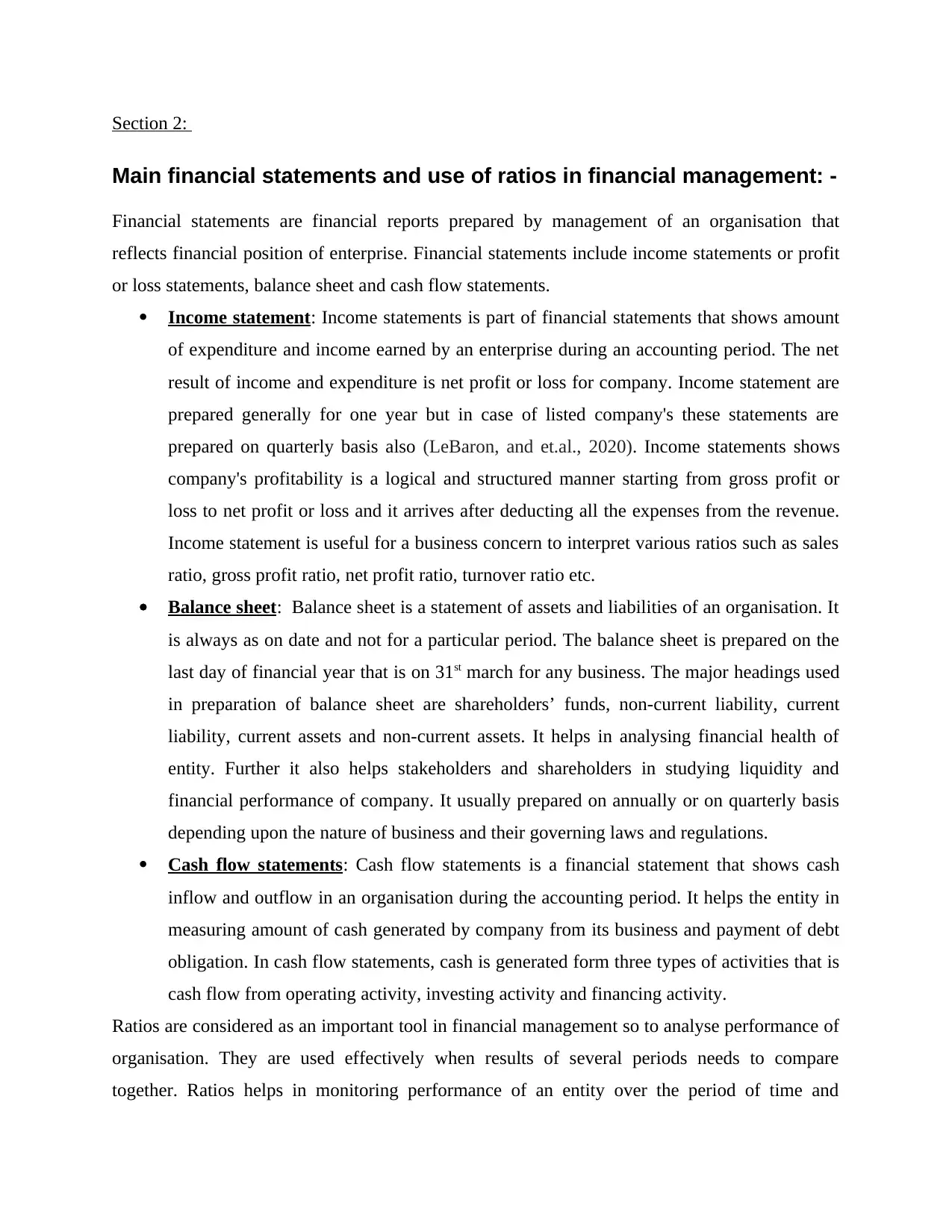
Section 2:
Main financial statements and use of ratios in financial management: -
Financial statements are financial reports prepared by management of an organisation that
reflects financial position of enterprise. Financial statements include income statements or profit
or loss statements, balance sheet and cash flow statements.
Income statement: Income statements is part of financial statements that shows amount
of expenditure and income earned by an enterprise during an accounting period. The net
result of income and expenditure is net profit or loss for company. Income statement are
prepared generally for one year but in case of listed company's these statements are
prepared on quarterly basis also (LeBaron, and et.al., 2020). Income statements shows
company's profitability is a logical and structured manner starting from gross profit or
loss to net profit or loss and it arrives after deducting all the expenses from the revenue.
Income statement is useful for a business concern to interpret various ratios such as sales
ratio, gross profit ratio, net profit ratio, turnover ratio etc.
Balance sheet: Balance sheet is a statement of assets and liabilities of an organisation. It
is always as on date and not for a particular period. The balance sheet is prepared on the
last day of financial year that is on 31st march for any business. The major headings used
in preparation of balance sheet are shareholders’ funds, non-current liability, current
liability, current assets and non-current assets. It helps in analysing financial health of
entity. Further it also helps stakeholders and shareholders in studying liquidity and
financial performance of company. It usually prepared on annually or on quarterly basis
depending upon the nature of business and their governing laws and regulations.
Cash flow statements: Cash flow statements is a financial statement that shows cash
inflow and outflow in an organisation during the accounting period. It helps the entity in
measuring amount of cash generated by company from its business and payment of debt
obligation. In cash flow statements, cash is generated form three types of activities that is
cash flow from operating activity, investing activity and financing activity.
Ratios are considered as an important tool in financial management so to analyse performance of
organisation. They are used effectively when results of several periods needs to compare
together. Ratios helps in monitoring performance of an entity over the period of time and
Main financial statements and use of ratios in financial management: -
Financial statements are financial reports prepared by management of an organisation that
reflects financial position of enterprise. Financial statements include income statements or profit
or loss statements, balance sheet and cash flow statements.
Income statement: Income statements is part of financial statements that shows amount
of expenditure and income earned by an enterprise during an accounting period. The net
result of income and expenditure is net profit or loss for company. Income statement are
prepared generally for one year but in case of listed company's these statements are
prepared on quarterly basis also (LeBaron, and et.al., 2020). Income statements shows
company's profitability is a logical and structured manner starting from gross profit or
loss to net profit or loss and it arrives after deducting all the expenses from the revenue.
Income statement is useful for a business concern to interpret various ratios such as sales
ratio, gross profit ratio, net profit ratio, turnover ratio etc.
Balance sheet: Balance sheet is a statement of assets and liabilities of an organisation. It
is always as on date and not for a particular period. The balance sheet is prepared on the
last day of financial year that is on 31st march for any business. The major headings used
in preparation of balance sheet are shareholders’ funds, non-current liability, current
liability, current assets and non-current assets. It helps in analysing financial health of
entity. Further it also helps stakeholders and shareholders in studying liquidity and
financial performance of company. It usually prepared on annually or on quarterly basis
depending upon the nature of business and their governing laws and regulations.
Cash flow statements: Cash flow statements is a financial statement that shows cash
inflow and outflow in an organisation during the accounting period. It helps the entity in
measuring amount of cash generated by company from its business and payment of debt
obligation. In cash flow statements, cash is generated form three types of activities that is
cash flow from operating activity, investing activity and financing activity.
Ratios are considered as an important tool in financial management so to analyse performance of
organisation. They are used effectively when results of several periods needs to compare
together. Ratios helps in monitoring performance of an entity over the period of time and
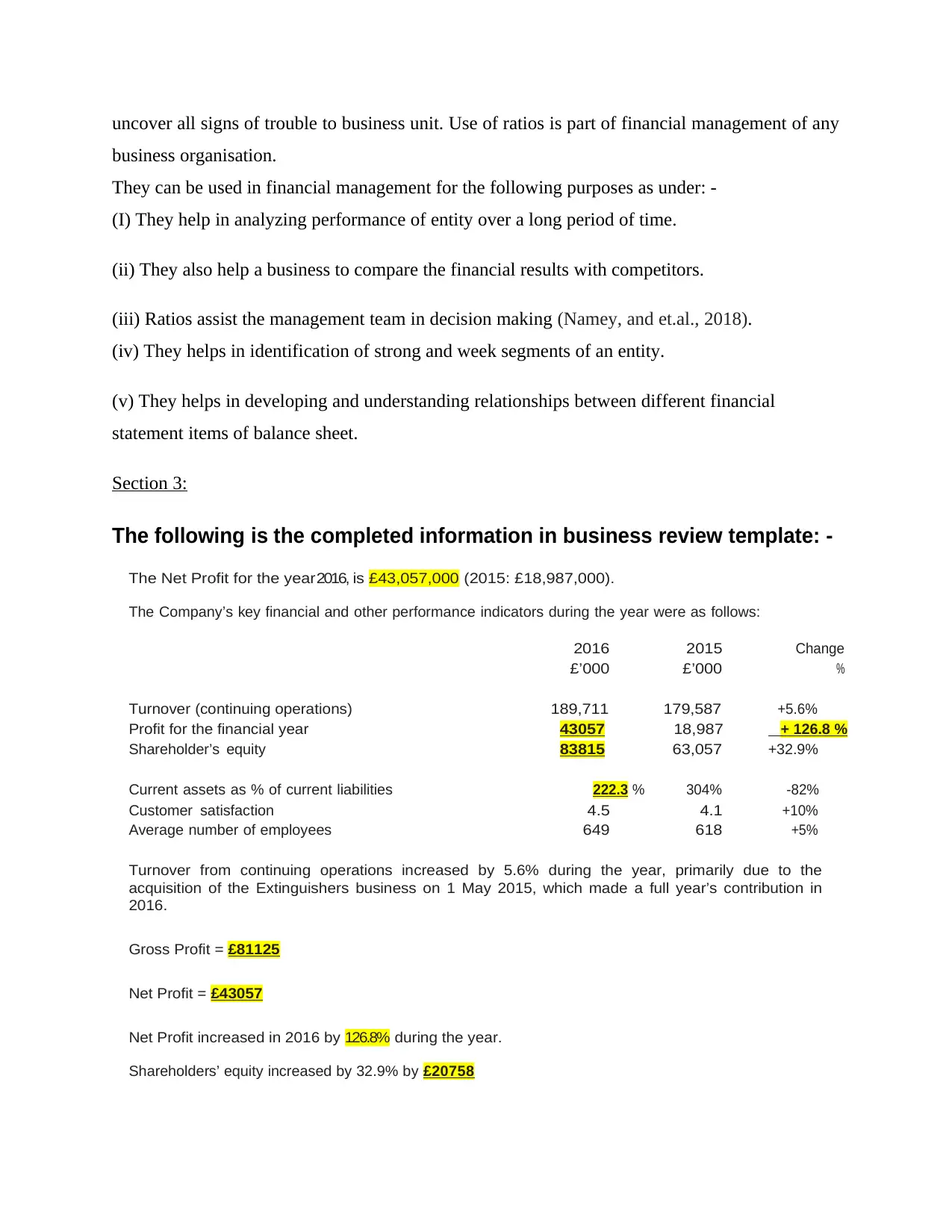
uncover all signs of trouble to business unit. Use of ratios is part of financial management of any
business organisation.
They can be used in financial management for the following purposes as under: -
(I) They help in analyzing performance of entity over a long period of time.
(ii) They also help a business to compare the financial results with competitors.
(iii) Ratios assist the management team in decision making (Namey, and et.al., 2018).
(iv) They helps in identification of strong and week segments of an entity.
(v) They helps in developing and understanding relationships between different financial
statement items of balance sheet.
Section 3:
The following is the completed information in business review template: -
The Net Profit for the year 2016, is £43,057,000 (2015: £18,987,000).
The Company’s key financial and other performance indicators during the year were as follows:
2016
£’000
2015
£’000
Change
%
Turnover (continuing operations) 189,711 179,587 +5.6%
Profit for the financial year 43057 18,987 + 126.8 %
Shareholder’s equity 83815 63,057 +32.9%
Current assets as % of current liabilities 222.3 % 304% -82%
Customer satisfaction 4.5 4.1 +10%
Average number of employees 649 618 +5%
Turnover from continuing operations increased by 5.6% during the year, primarily due to the
acquisition of the Extinguishers business on 1 May 2015, which made a full year’s contribution in
2016.
Gross Profit = £81125
Net Profit = £43057
Net Profit increased in 2016 by 126.8% during the year.
Shareholders’ equity increased by 32.9% by £20758
business organisation.
They can be used in financial management for the following purposes as under: -
(I) They help in analyzing performance of entity over a long period of time.
(ii) They also help a business to compare the financial results with competitors.
(iii) Ratios assist the management team in decision making (Namey, and et.al., 2018).
(iv) They helps in identification of strong and week segments of an entity.
(v) They helps in developing and understanding relationships between different financial
statement items of balance sheet.
Section 3:
The following is the completed information in business review template: -
The Net Profit for the year 2016, is £43,057,000 (2015: £18,987,000).
The Company’s key financial and other performance indicators during the year were as follows:
2016
£’000
2015
£’000
Change
%
Turnover (continuing operations) 189,711 179,587 +5.6%
Profit for the financial year 43057 18,987 + 126.8 %
Shareholder’s equity 83815 63,057 +32.9%
Current assets as % of current liabilities 222.3 % 304% -82%
Customer satisfaction 4.5 4.1 +10%
Average number of employees 649 618 +5%
Turnover from continuing operations increased by 5.6% during the year, primarily due to the
acquisition of the Extinguishers business on 1 May 2015, which made a full year’s contribution in
2016.
Gross Profit = £81125
Net Profit = £43057
Net Profit increased in 2016 by 126.8% during the year.
Shareholders’ equity increased by 32.9% by £20758
⊘ This is a preview!⊘
Do you want full access?
Subscribe today to unlock all pages.

Trusted by 1+ million students worldwide
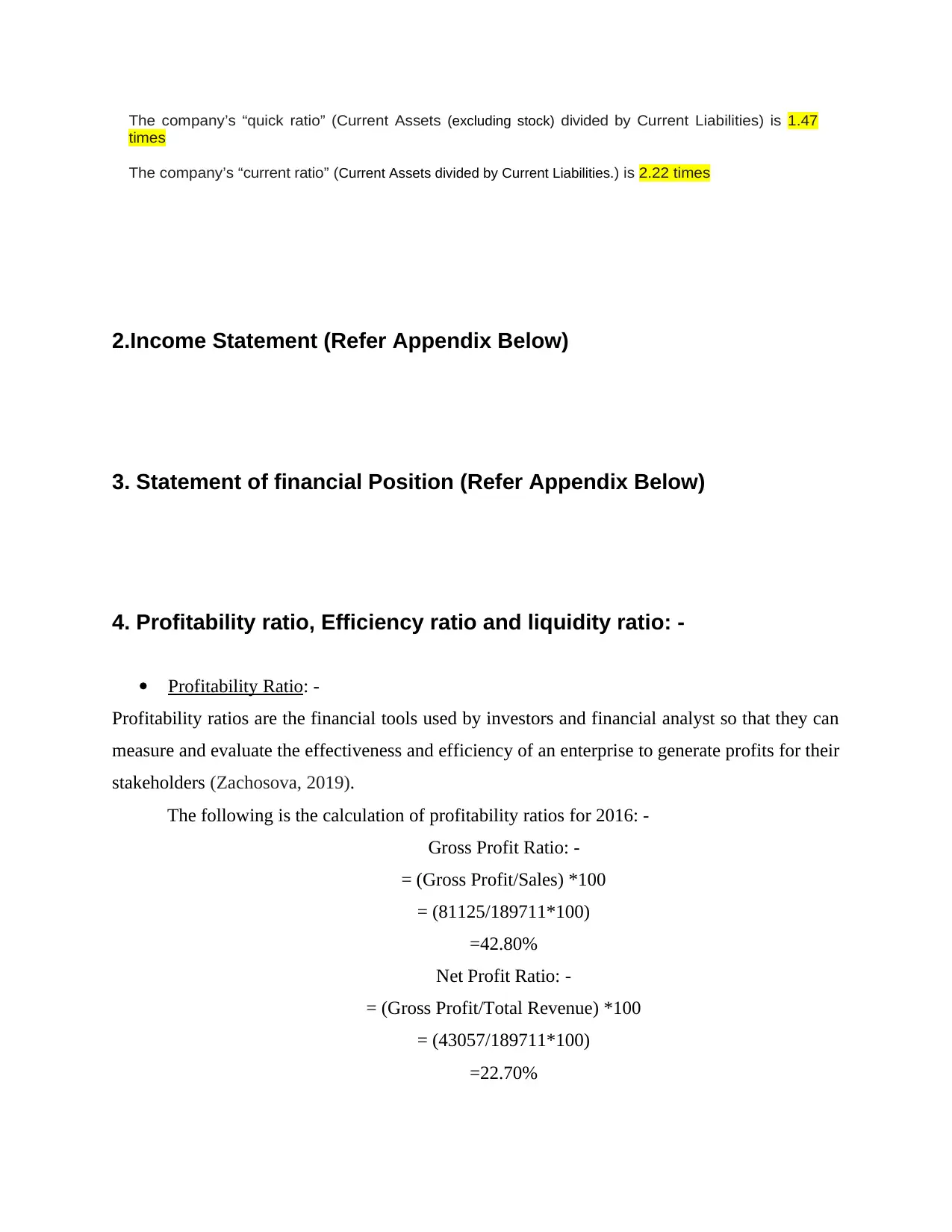
The company’s “quick ratio” (Current Assets (excluding stock) divided by Current Liabilities) is 1.47
times
The company’s “current ratio” (Current Assets divided by Current Liabilities. ) is 2.22 times
2.Income Statement (Refer Appendix Below)
3. Statement of financial Position (Refer Appendix Below)
4. Profitability ratio, Efficiency ratio and liquidity ratio: -
Profitability Ratio: -
Profitability ratios are the financial tools used by investors and financial analyst so that they can
measure and evaluate the effectiveness and efficiency of an enterprise to generate profits for their
stakeholders (Zachosova, 2019).
The following is the calculation of profitability ratios for 2016: -
Gross Profit Ratio: -
= (Gross Profit/Sales) *100
= (81125/189711*100)
=42.80%
Net Profit Ratio: -
= (Gross Profit/Total Revenue) *100
= (43057/189711*100)
=22.70%
times
The company’s “current ratio” (Current Assets divided by Current Liabilities. ) is 2.22 times
2.Income Statement (Refer Appendix Below)
3. Statement of financial Position (Refer Appendix Below)
4. Profitability ratio, Efficiency ratio and liquidity ratio: -
Profitability Ratio: -
Profitability ratios are the financial tools used by investors and financial analyst so that they can
measure and evaluate the effectiveness and efficiency of an enterprise to generate profits for their
stakeholders (Zachosova, 2019).
The following is the calculation of profitability ratios for 2016: -
Gross Profit Ratio: -
= (Gross Profit/Sales) *100
= (81125/189711*100)
=42.80%
Net Profit Ratio: -
= (Gross Profit/Total Revenue) *100
= (43057/189711*100)
=22.70%
Paraphrase This Document
Need a fresh take? Get an instant paraphrase of this document with our AI Paraphraser
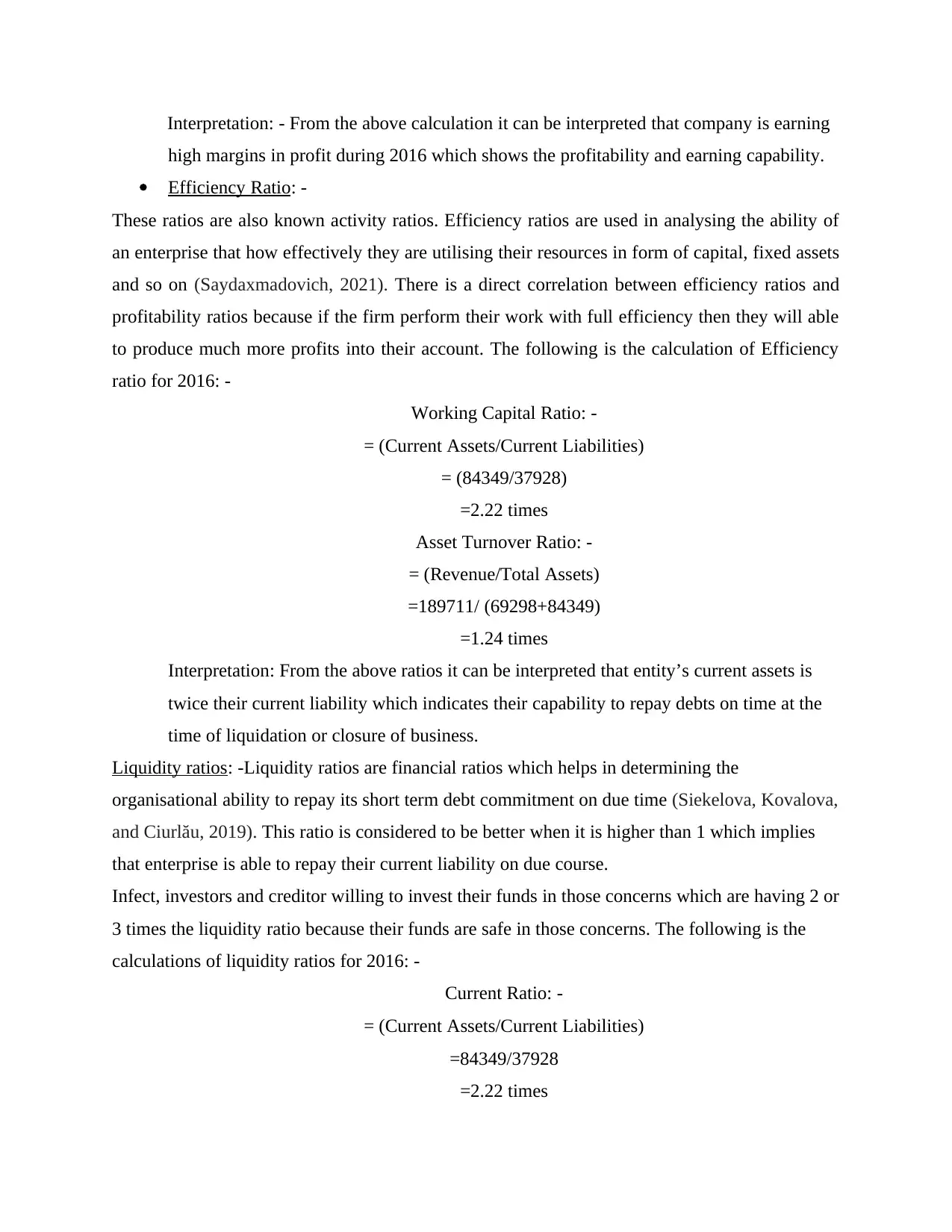
Interpretation: - From the above calculation it can be interpreted that company is earning
high margins in profit during 2016 which shows the profitability and earning capability.
Efficiency Ratio: -
These ratios are also known activity ratios. Efficiency ratios are used in analysing the ability of
an enterprise that how effectively they are utilising their resources in form of capital, fixed assets
and so on (Saydaxmadovich, 2021). There is a direct correlation between efficiency ratios and
profitability ratios because if the firm perform their work with full efficiency then they will able
to produce much more profits into their account. The following is the calculation of Efficiency
ratio for 2016: -
Working Capital Ratio: -
= (Current Assets/Current Liabilities)
= (84349/37928)
=2.22 times
Asset Turnover Ratio: -
= (Revenue/Total Assets)
=189711/ (69298+84349)
=1.24 times
Interpretation: From the above ratios it can be interpreted that entity’s current assets is
twice their current liability which indicates their capability to repay debts on time at the
time of liquidation or closure of business.
Liquidity ratios: -Liquidity ratios are financial ratios which helps in determining the
organisational ability to repay its short term debt commitment on due time (Siekelova, Kovalova,
and Ciurlău, 2019). This ratio is considered to be better when it is higher than 1 which implies
that enterprise is able to repay their current liability on due course.
Infect, investors and creditor willing to invest their funds in those concerns which are having 2 or
3 times the liquidity ratio because their funds are safe in those concerns. The following is the
calculations of liquidity ratios for 2016: -
Current Ratio: -
= (Current Assets/Current Liabilities)
=84349/37928
=2.22 times
high margins in profit during 2016 which shows the profitability and earning capability.
Efficiency Ratio: -
These ratios are also known activity ratios. Efficiency ratios are used in analysing the ability of
an enterprise that how effectively they are utilising their resources in form of capital, fixed assets
and so on (Saydaxmadovich, 2021). There is a direct correlation between efficiency ratios and
profitability ratios because if the firm perform their work with full efficiency then they will able
to produce much more profits into their account. The following is the calculation of Efficiency
ratio for 2016: -
Working Capital Ratio: -
= (Current Assets/Current Liabilities)
= (84349/37928)
=2.22 times
Asset Turnover Ratio: -
= (Revenue/Total Assets)
=189711/ (69298+84349)
=1.24 times
Interpretation: From the above ratios it can be interpreted that entity’s current assets is
twice their current liability which indicates their capability to repay debts on time at the
time of liquidation or closure of business.
Liquidity ratios: -Liquidity ratios are financial ratios which helps in determining the
organisational ability to repay its short term debt commitment on due time (Siekelova, Kovalova,
and Ciurlău, 2019). This ratio is considered to be better when it is higher than 1 which implies
that enterprise is able to repay their current liability on due course.
Infect, investors and creditor willing to invest their funds in those concerns which are having 2 or
3 times the liquidity ratio because their funds are safe in those concerns. The following is the
calculations of liquidity ratios for 2016: -
Current Ratio: -
= (Current Assets/Current Liabilities)
=84349/37928
=2.22 times
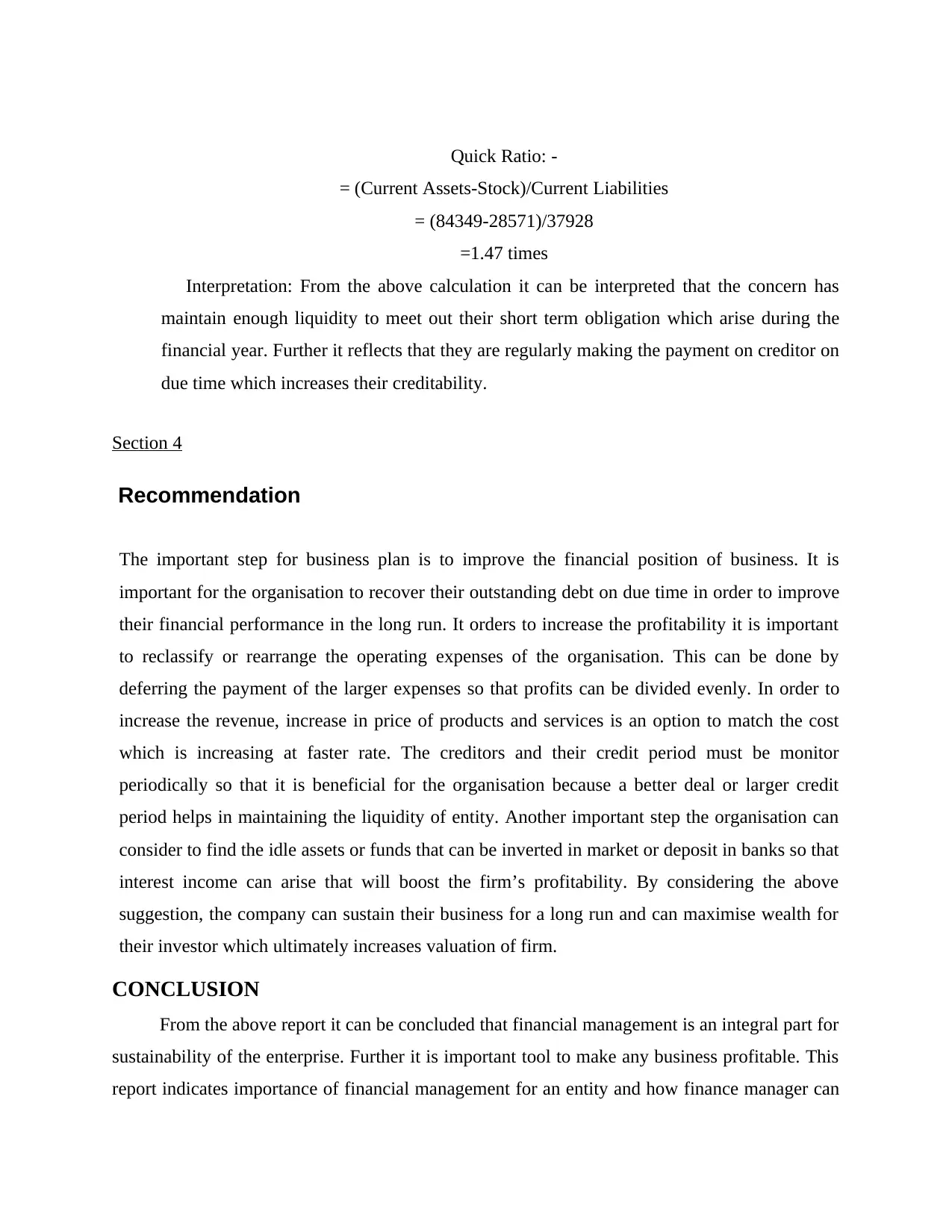
Quick Ratio: -
= (Current Assets-Stock)/Current Liabilities
= (84349-28571)/37928
=1.47 times
Interpretation: From the above calculation it can be interpreted that the concern has
maintain enough liquidity to meet out their short term obligation which arise during the
financial year. Further it reflects that they are regularly making the payment on creditor on
due time which increases their creditability.
Section 4
Recommendation
The important step for business plan is to improve the financial position of business. It is
important for the organisation to recover their outstanding debt on due time in order to improve
their financial performance in the long run. It orders to increase the profitability it is important
to reclassify or rearrange the operating expenses of the organisation. This can be done by
deferring the payment of the larger expenses so that profits can be divided evenly. In order to
increase the revenue, increase in price of products and services is an option to match the cost
which is increasing at faster rate. The creditors and their credit period must be monitor
periodically so that it is beneficial for the organisation because a better deal or larger credit
period helps in maintaining the liquidity of entity. Another important step the organisation can
consider to find the idle assets or funds that can be inverted in market or deposit in banks so that
interest income can arise that will boost the firm’s profitability. By considering the above
suggestion, the company can sustain their business for a long run and can maximise wealth for
their investor which ultimately increases valuation of firm.
CONCLUSION
From the above report it can be concluded that financial management is an integral part for
sustainability of the enterprise. Further it is important tool to make any business profitable. This
report indicates importance of financial management for an entity and how finance manager can
= (Current Assets-Stock)/Current Liabilities
= (84349-28571)/37928
=1.47 times
Interpretation: From the above calculation it can be interpreted that the concern has
maintain enough liquidity to meet out their short term obligation which arise during the
financial year. Further it reflects that they are regularly making the payment on creditor on
due time which increases their creditability.
Section 4
Recommendation
The important step for business plan is to improve the financial position of business. It is
important for the organisation to recover their outstanding debt on due time in order to improve
their financial performance in the long run. It orders to increase the profitability it is important
to reclassify or rearrange the operating expenses of the organisation. This can be done by
deferring the payment of the larger expenses so that profits can be divided evenly. In order to
increase the revenue, increase in price of products and services is an option to match the cost
which is increasing at faster rate. The creditors and their credit period must be monitor
periodically so that it is beneficial for the organisation because a better deal or larger credit
period helps in maintaining the liquidity of entity. Another important step the organisation can
consider to find the idle assets or funds that can be inverted in market or deposit in banks so that
interest income can arise that will boost the firm’s profitability. By considering the above
suggestion, the company can sustain their business for a long run and can maximise wealth for
their investor which ultimately increases valuation of firm.
CONCLUSION
From the above report it can be concluded that financial management is an integral part for
sustainability of the enterprise. Further it is important tool to make any business profitable. This
report indicates importance of financial management for an entity and how finance manager can
⊘ This is a preview!⊘
Do you want full access?
Subscribe today to unlock all pages.

Trusted by 1+ million students worldwide
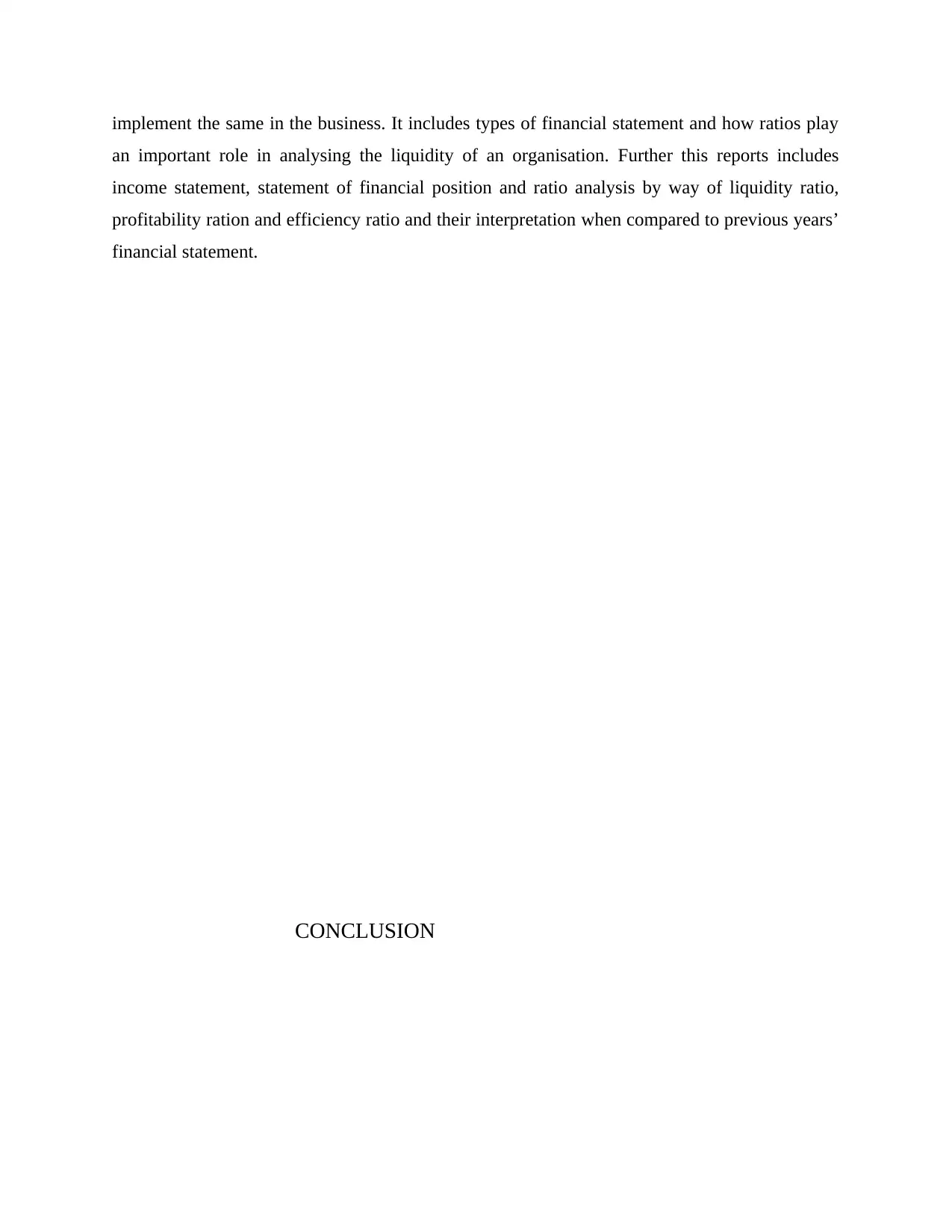
implement the same in the business. It includes types of financial statement and how ratios play
an important role in analysing the liquidity of an organisation. Further this reports includes
income statement, statement of financial position and ratio analysis by way of liquidity ratio,
profitability ration and efficiency ratio and their interpretation when compared to previous years’
financial statement.
FacebookTwitterEmailPinterestCONCLUSION
an important role in analysing the liquidity of an organisation. Further this reports includes
income statement, statement of financial position and ratio analysis by way of liquidity ratio,
profitability ration and efficiency ratio and their interpretation when compared to previous years’
financial statement.
FacebookTwitterEmailPinterestCONCLUSION
Paraphrase This Document
Need a fresh take? Get an instant paraphrase of this document with our AI Paraphraser
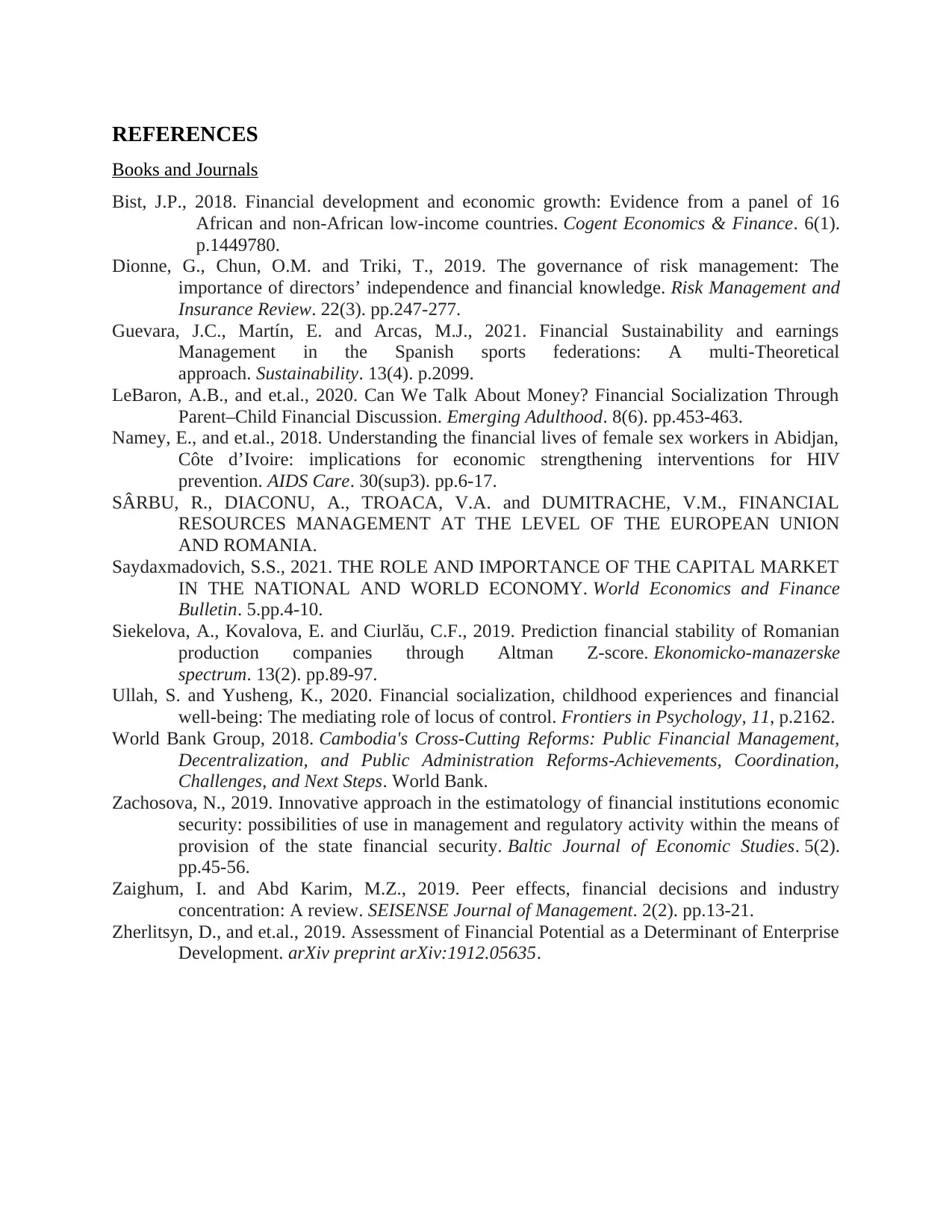
REFERENCES
Books and Journals
Bist, J.P., 2018. Financial development and economic growth: Evidence from a panel of 16
African and non-African low-income countries. Cogent Economics & Finance. 6(1).
p.1449780.
Dionne, G., Chun, O.M. and Triki, T., 2019. The governance of risk management: The
importance of directors’ independence and financial knowledge. Risk Management and
Insurance Review. 22(3). pp.247-277.
Guevara, J.C., Martín, E. and Arcas, M.J., 2021. Financial Sustainability and earnings
Management in the Spanish sports federations: A multi-Theoretical
approach. Sustainability. 13(4). p.2099.
LeBaron, A.B., and et.al., 2020. Can We Talk About Money? Financial Socialization Through
Parent–Child Financial Discussion. Emerging Adulthood. 8(6). pp.453-463.
Namey, E., and et.al., 2018. Understanding the financial lives of female sex workers in Abidjan,
Côte d’Ivoire: implications for economic strengthening interventions for HIV
prevention. AIDS Care. 30(sup3). pp.6-17.
SÂRBU, R., DIACONU, A., TROACA, V.A. and DUMITRACHE, V.M., FINANCIAL
RESOURCES MANAGEMENT AT THE LEVEL OF THE EUROPEAN UNION
AND ROMANIA.
Saydaxmadovich, S.S., 2021. THE ROLE AND IMPORTANCE OF THE CAPITAL MARKET
IN THE NATIONAL AND WORLD ECONOMY. World Economics and Finance
Bulletin. 5.pp.4-10.
Siekelova, A., Kovalova, E. and Ciurlău, C.F., 2019. Prediction financial stability of Romanian
production companies through Altman Z-score. Ekonomicko-manazerske
spectrum. 13(2). pp.89-97.
Ullah, S. and Yusheng, K., 2020. Financial socialization, childhood experiences and financial
well-being: The mediating role of locus of control. Frontiers in Psychology, 11, p.2162.
World Bank Group, 2018. Cambodia's Cross-Cutting Reforms: Public Financial Management,
Decentralization, and Public Administration Reforms-Achievements, Coordination,
Challenges, and Next Steps. World Bank.
Zachosova, N., 2019. Innovative approach in the estimatology of financial institutions economic
security: possibilities of use in management and regulatory activity within the means of
provision of the state financial security. Baltic Journal of Economic Studies. 5(2).
pp.45-56.
Zaighum, I. and Abd Karim, M.Z., 2019. Peer effects, financial decisions and industry
concentration: A review. SEISENSE Journal of Management. 2(2). pp.13-21.
Zherlitsyn, D., and et.al., 2019. Assessment of Financial Potential as a Determinant of Enterprise
Development. arXiv preprint arXiv:1912.05635.
Books and Journals
Bist, J.P., 2018. Financial development and economic growth: Evidence from a panel of 16
African and non-African low-income countries. Cogent Economics & Finance. 6(1).
p.1449780.
Dionne, G., Chun, O.M. and Triki, T., 2019. The governance of risk management: The
importance of directors’ independence and financial knowledge. Risk Management and
Insurance Review. 22(3). pp.247-277.
Guevara, J.C., Martín, E. and Arcas, M.J., 2021. Financial Sustainability and earnings
Management in the Spanish sports federations: A multi-Theoretical
approach. Sustainability. 13(4). p.2099.
LeBaron, A.B., and et.al., 2020. Can We Talk About Money? Financial Socialization Through
Parent–Child Financial Discussion. Emerging Adulthood. 8(6). pp.453-463.
Namey, E., and et.al., 2018. Understanding the financial lives of female sex workers in Abidjan,
Côte d’Ivoire: implications for economic strengthening interventions for HIV
prevention. AIDS Care. 30(sup3). pp.6-17.
SÂRBU, R., DIACONU, A., TROACA, V.A. and DUMITRACHE, V.M., FINANCIAL
RESOURCES MANAGEMENT AT THE LEVEL OF THE EUROPEAN UNION
AND ROMANIA.
Saydaxmadovich, S.S., 2021. THE ROLE AND IMPORTANCE OF THE CAPITAL MARKET
IN THE NATIONAL AND WORLD ECONOMY. World Economics and Finance
Bulletin. 5.pp.4-10.
Siekelova, A., Kovalova, E. and Ciurlău, C.F., 2019. Prediction financial stability of Romanian
production companies through Altman Z-score. Ekonomicko-manazerske
spectrum. 13(2). pp.89-97.
Ullah, S. and Yusheng, K., 2020. Financial socialization, childhood experiences and financial
well-being: The mediating role of locus of control. Frontiers in Psychology, 11, p.2162.
World Bank Group, 2018. Cambodia's Cross-Cutting Reforms: Public Financial Management,
Decentralization, and Public Administration Reforms-Achievements, Coordination,
Challenges, and Next Steps. World Bank.
Zachosova, N., 2019. Innovative approach in the estimatology of financial institutions economic
security: possibilities of use in management and regulatory activity within the means of
provision of the state financial security. Baltic Journal of Economic Studies. 5(2).
pp.45-56.
Zaighum, I. and Abd Karim, M.Z., 2019. Peer effects, financial decisions and industry
concentration: A review. SEISENSE Journal of Management. 2(2). pp.13-21.
Zherlitsyn, D., and et.al., 2019. Assessment of Financial Potential as a Determinant of Enterprise
Development. arXiv preprint arXiv:1912.05635.
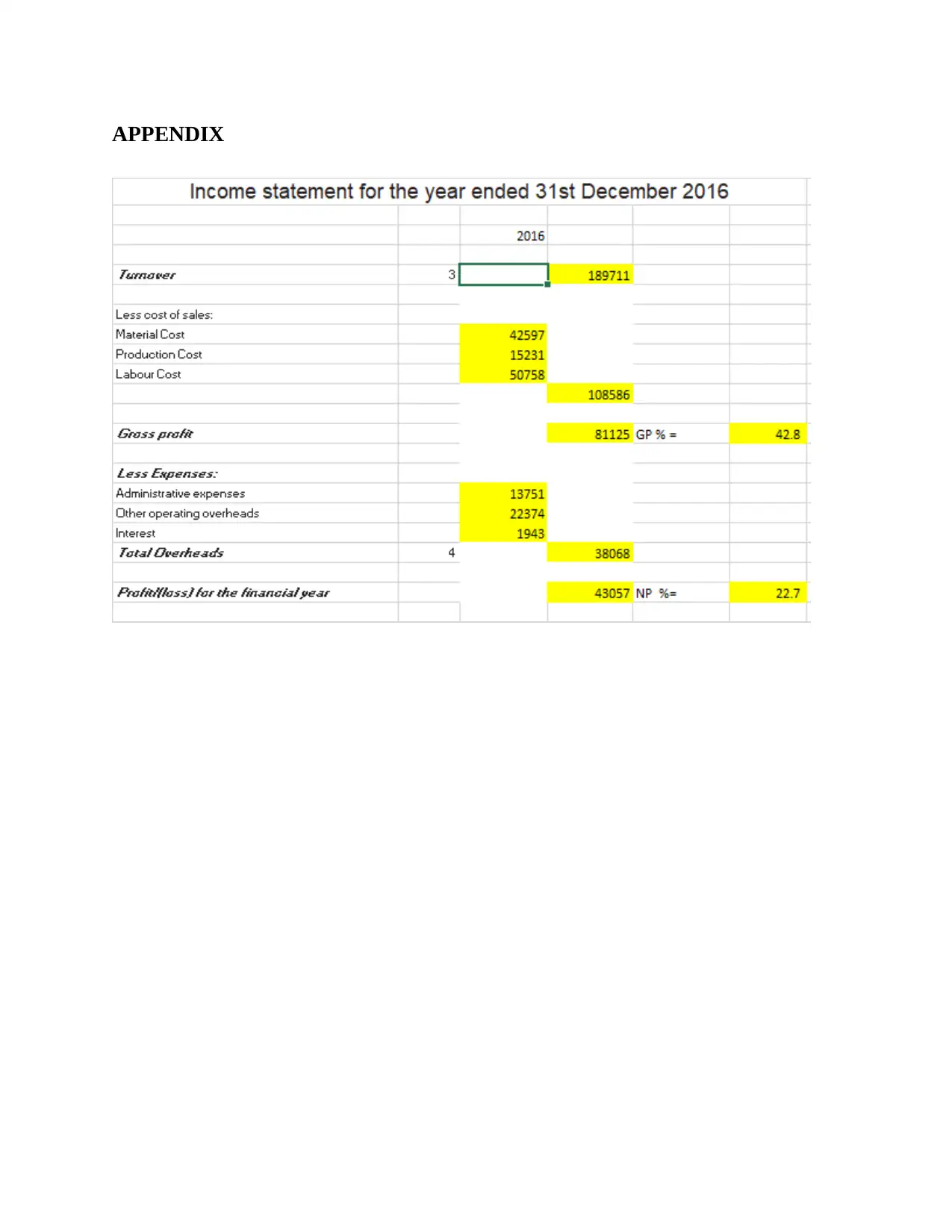
APPENDIX
⊘ This is a preview!⊘
Do you want full access?
Subscribe today to unlock all pages.

Trusted by 1+ million students worldwide
1 out of 14
Related Documents
Your All-in-One AI-Powered Toolkit for Academic Success.
+13062052269
info@desklib.com
Available 24*7 on WhatsApp / Email
![[object Object]](/_next/static/media/star-bottom.7253800d.svg)
Unlock your academic potential
Copyright © 2020–2025 A2Z Services. All Rights Reserved. Developed and managed by ZUCOL.



